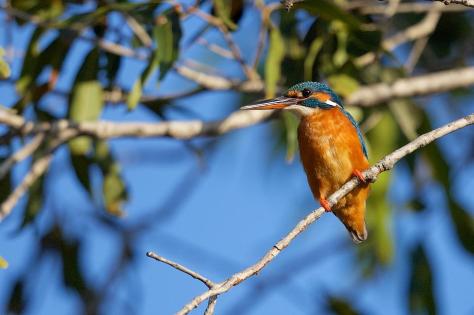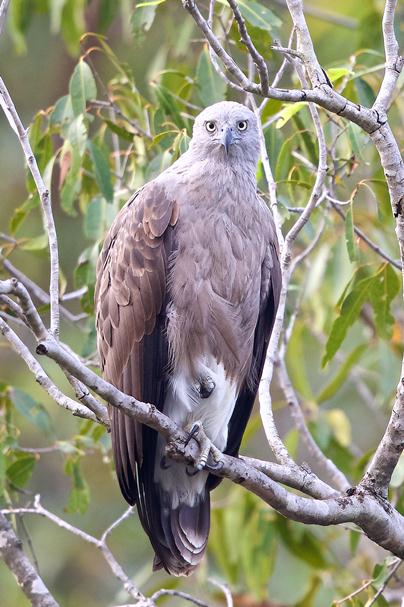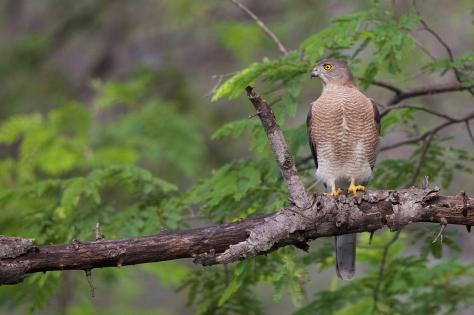Dates: 16-19 Dec, 2015
Camp: Sunderban Jungle Camp on Bali Island
Who: VV, GK and my 8-year-old son P
A couple of near-miss-sightings of mama last time pushed us to try our luck again. And the prospect of winter birding.

Blue tiger
Getting to Sunderbans jungle camp involves a three hour drive along poor, narrow roads from Kolkata, to cover less than 100 kms to Godkhali. From here, the boat is boarded, and it winds its way up the Durgaduani channel and to the Gumdi river on the banks of which the camp is sited, on Bali island. On the way back, Animesh brought us around Bali island the long way, up the Bidya river, to look for waders.
The weather was strange. Day 1 was hot and sunny and we scrambled for whatever scanty shade was available on the upper deck. Day 2 was freezing cold, especially when the boat faced north – owing to the uttore batash – northern wind – that chilled us to the bone. Day 3 was equally cold but with persistent rain, forcing us to seek the shelter of the lower deck at least once. Day 4 was moderately cool with some sunshine. Someone joked that we’d experienced three seasons all in one trip.

The forest looked freshly washed and hauntingly beautiful after the rain
Animesh Manna was his usual competent, thorough self, and we got a boatman with unbelievable spotting skills this time – Mahadev.
Most days we got back early, by 5 or 5:30 PM, giving us a little daylight before the early sunset to wander around the embankment by the camp. A Taiga flycatcher was a regular habitue around the harvested rice paddies and fish ponds that chequer the countryside. Yellow-browed warblers were ubiquitous, here and in the forest. A brood of spotted owlets was resident.

Common kingfisher
We watched a pair of checkered keelbacks hunting among the reeds of one of the fish ponds. Animesh unearthed a little rat snake while looking for bitterns and we took some pictures.
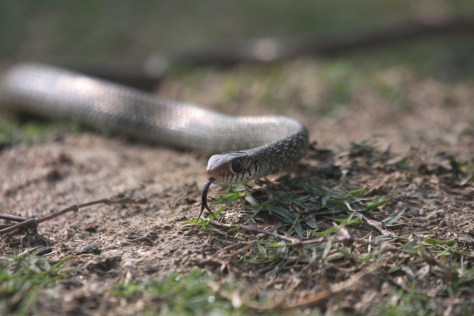
Rat snake
While walking by another pond, GK and I startled a snake by nearly stepping on it, sending it darting away and into the water. Dark green in colour and over a couple of feet in length. Animesh was a short way away but surmised that it was either an Olive keelback (which is what I had thought) or a Smooth-scaled watersnake.

Mudskipper

Slug leaving a clay-pellet trail
On the last day, we did a little country-boat ride up one of the narrow channels nearby. The nearby village was hidden behind a wall of mangrove vegetation, giving us an idea of what a small-boat ride in the forest would feel like. Considering the stories one heard in the Sunderbans of tiger attacks, sitting low down in the water with the banks a couple of feet away on both sides brought home the vulnerability of crab fishermen who sneak into the forest channels. Our boatman was a chap who’d survived an incredible run-in with a tiger. This had happened just two months before our last visit and we’d met him then too. He was still recovering from the shock of the incident apparently.
The story went like this. This fellow, along with a couple of friends ventured into a channel across the Gumdi, in the forest. The trio spotted a tiger a short distance away and one of them panicked and slipped off the boat. The cat pounced on the man in a trice and disappeared with him into the mangroves. The third man collapsed in a state of panic but our friend brought the boat around and stepped into the jungle alone and on foot, armed with just his paddle. Running into the tiger he charged it with the paddle, and it dropped the dead man and disappeared. He then hauled the body back to the village. And gave up illegal crab fishing ever since.

One of the five “fingers” that radiate from the Sudanykhali watchtower. This tower was the one I meant in my last post when I mistakenly referred to the Sajnekhali watchtower producing great sightings.
In the forest we found a set of birds that were almost completely different from the ones we encountered the last time.
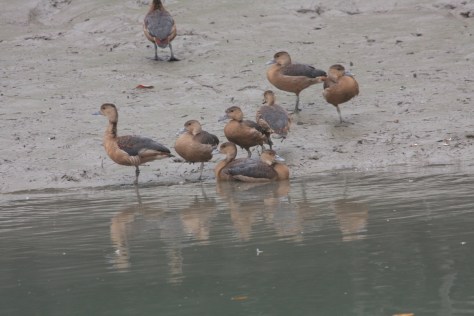
Lesser whistling ducks
Black-capped kingfisher were commonplace and their calls, reminiscent of the White-throated kingfisher’s were frequently heard.

Vacated nest of Purple-rumped sunbird showing the curtained hatch
Common sandpipers were found along the banks almost everywhere, and their whistling calls were a constant too.

Common sandpiper
Magpie robin, Yellow-browed warbler, Collared dove and tailorbird called incessantly. Dusky warbler called occasionally. Great and little egret, Jungle crow and Little heron were commonly seen.

Little heron
The collared kingfisher that was so common in May was missing this time, and we only saw a couple.

Collared kingfisher

Common redshank

Red junglefowl
Brown-winged kingfisher were seen far more frequently than the last time.

Brown-winged kingfisher
The Mangrove pitta, which was heard quite a bit around Sudhanykhali watchtower the last time was silent at this time of year. The dark morph CHE had not been seen for a while around Sudhanykhali.
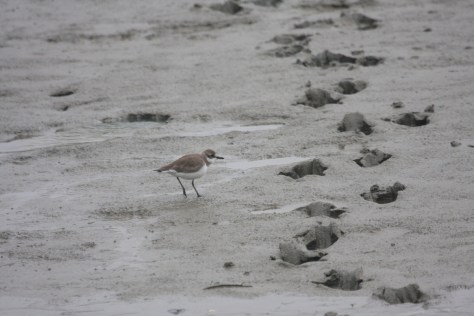
Lesser sand plover and tiger pugmarks

Water monitor – we anchored the boat to have lunch in this lizard’s company, but he had other ideas and promptly disappeared
Animesh helped me improve on my ability to identify mangrove trees further.
- Avicennia alba – Kalu bayan – with its black trunk and sharp, narrow leaves
- Avicennia officinalis – Jath bayan – easiest of the genus to identify, with its smooth pale bark, rounded leaves and distinct branching structure

Avicennia officinalis showing profusion of aerial roots
- Avicennia marina – Peara bayan – with its mango-like leaves and pale blotchy trunk very much like the guava tree’s
- Ceriops tagal – Moth goran – with its dome-like shape and knee-roots

Knee roots of Ceriops tagal
- Bruguiera gymnorrhiza – Kankra – with its buttress roots and distinct leaves

Red flowers of Kankra (Bruguiera gymnorrhiza)
- Heritiera fomes – Sundari – with its Christmas-tree-like structure and branching pattern
- Sonneratia apetala – Kewra – with its pencil roots
- Xylocarpus granatum – Dhundul – with its melon-like fruit

Xylocarpus granatum fruit
- Xylocarpus mekongensis – Passur – with its thick pneumatophores

Pneumatophores of Passur (Xylocarpus mekongensis)
Jhamti goran Ceriops decandra, Garjan Rhozophora apiculate and Kholsi Aegiceras corniculatum are not too difficult to ID in general.

Garjan (Rhizophora apiculata) showing stilt roots
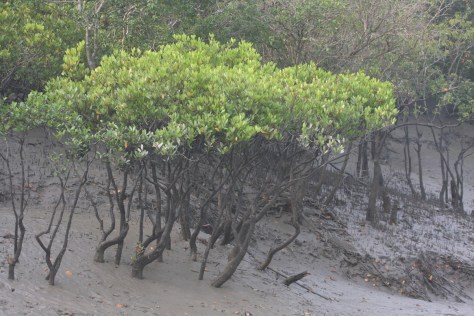
Kholsi (Aegiceras corniculatum)
GK carried home a Kankra Bruguiera gymnorrhiza sapling and a red water lily. The latter will probably survive, but it will be interesting to see how the mangrove tree copes in Chennai.

The lighter green patch is mistletoe – a hemiparasite
The issue with the Sunderbans is that while tiger sightings are rare, near-misses are not – and this always leaves a tantalizing window open for a repeat visit. We were at Sudhanykhali watchtower at 8:30 AM one morning and after we left, at 9:30 AM, a big male tiger walked right passed the watchtower and crossed the channel. It is this sort of thing that tempts us to return for yet another attempt.

Birds
- Ashy woodswallow
- Black-winged cuckooshrike
- Brahminy kite
- Brown-winged kingfisher
- Black-capped kingfisher
- Bronzed drongo
- Brown shrike
- Cinereous tit
- Common iora
- Common myna
- Common redshank
- Common sandpiper
- Common tailorbird
- Dusky warbler
- Eurasian collared dove
- Eurasian wigeon
- Eurasian wryneck (VV only)
- Gadwall
- Great egret
- Green bee-eater
- Grey junglefowl
- Grey wagtail
- Indian spotted eagle
- Indian treepie
- Jungle babbler
- Jungle crow
- Lesser flameback
- Lesser sand plover
- Lesser whistling duck
- Little egret
- Little heron
- Magpie robin
- Night heron
- Oriental white-eye
- Osprey
- Pied kingfisher
- Pin-striped tit babbler (calls)
- Pond heron
- Purple-rumped sunbird
- Rose-ringed parakeet
- Shikra
- Small minivet
- Spotted dove
- Spotted owlet
- Taiga flycatcher
- Terek sandpiper
- Tickell’s blue flycatcher
- Whimbrel
- White-breasted waterhen
- White-throated fantail
- White-throated kingfisher
- Yellow-browed warbler
Mammals
- Chital
- Rhesus macaque
- Wild boar
Reptiles
- Checkered keelback
- Estuarine crocodile
- Rat snake
- Water monitor
- Olive keelback?
